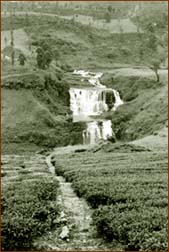
St. Clairs falls
Picture by Gamini Susantha
Sri Lanka Genealogy Website
Preserving our Cascading Beauties - a priority task
by Florence Wickramage - DN Tue may 11 2004
I remember visiting the quaint St. Andrew's Church in Haputale on one of my visits to our beautiful highlands. At this location stands the grave of W.S.Senior known as the Britisher with a Sri Lankan heart.
|
|
An epitaph on his grave reads, "Here soars our Island summit. Here I stand, in spirit, as in body once I stood, long years ago, in love with all the land, this peerless land of Beauty's plenitude". Standing atop the highest summit of the country he wrote these words. (Lanka, from Pidurutalagala). Senior composer of the famous 'Hymn for Ceylon', is one of many foreigners who fell in love with our magnificent isle - specially the scenic beauty of the hill country with its long winding rivers, the waterfalls, the velvety tea gardens, the bold and lofty peaks.
The abundance of waterfalls in the country is attributed to the geology of the country with its peneplains and rocky precipices combined with the quantum of rainfall in the hill country. Normally these falls are in "full bloom" during monsoon periods, shining silver ribbons streaming down mountain slopes on all sides.
Nestling in this hill country are the fascinating waterfalls about which Fr. Mervyn Fernando in his portfolio of Sri Lanka's Waterfalls - " Dancing Waters: Liquid Light" dedicated to the children of Sri Lanka says, "The waterfalls of Sri Lanka are symbolic of the beauty she offers her sons and daughters, beauty which must inspire them, to rise to the heights of truth, goodness, peace and love; to the "divine" abodes of metta, karuna, muditha and upekha, to make her the Paradise she is supposed to be".
Engrossed with nature and its various wonders, waterfalls have always held me spellbound with their mystic musical rhythms dancing and prancing from crag to crag or silently trailing downwards in layers of cascading gossamer veils in bright sunshine or pearly moonlight.
Research/Study
Sri Lanka has been blessed with as much as 382 waterfalls scattered throughout the island. Stepping into the limelight to instil into the public the importance of conserving our waterfalls due to their cultural value and the ties the `falls' have on the social life of the country, is the Lanka Council on Waterfalls (LCWF) known also as the Lanka Diyaeli Sansadaya.
This I believe is welcome news to environmentalists and nature lovers in the face of the many threats currently directed at some of our beautiful waterfalls in the name of development.
Three of our waterfalls - the Bambarakanda Fall, the Kurundu Oya Fall and the Diyaluma Fall have been included in the list of World's Highest Waterfalls ranking as the 48th, 58th and 62nd respectively in the list.
|
|
Research conducted by the LCWF has surfaced many waterfalls in several parts of the island which had hitherto existed unknown and unsung.
In August 2002 the LCWF conducted a research programme on Colombo District's Waterfalls i.e. the Dambora Fall, Ranmudu Fall, Kumari Fall and Ella Uda Fall. During workshops held in other parts of the country, the LCWF has discovered 19 waterfalls in the Sinharaja Rain Forest area, six waterfalls in the Kalutara District and nine waterfalls in the Matale District in addition to the well-known waterfalls in the island.
The LCWF among its many activities is currently focussing on workshops, seminars, research and study, data collection, compiling informative material, exploration of waterfalls, contributions to publications and songs based on waterfalls etc.
Constitution
The LCWF in compiling its constitution has included many far-sighted objectives.
They include increasing awareness and interest of the people with regards to the Water Falls in Sri Lanka whilst at the same time striving to create a deeper understanding of the social life and the culture built around these waterfalls with a view to protecting them; to improve the knowledge of local and foreign tourists about the Water Falls of Sri Lanka with the aim of minimizing possible threats to them; organizing workshops and seminars with latest techniques on how to conduct research on waterfalls to improve and enhance the knowledge of those engaged in research on waterfalls; to collect and store researched data on waterfalls, publish research papers, organize educational trips, conduct community based workshops and exhibitions with a view for LCWF to become the Sri Lankan study centre on waterfalls.
Threats
The LCWF is in the process of designing a website with the assistance of a South South Exchange Programme volunteer from Nepal Kedar Prasad Bhattari. Preparations are also underway for the forthcoming World Congress on Waterfalls to be held in the near future.
Several of our picturesque waterfalls including the beautiful Laxapana Fall had been used to generate hydropower for the country. Seven more beautiful waterfalls including the breathtakingly beautiful and exquisite St. Clair's Fall and the Devon Fall in the central highlands which are popular tourist attractions will be `doomed' if a proposed hydro-power generation scheme gets underway, much against the advice of experts and geologists.
The country has as much as 101 rivers and experts and environmentalists believe that mini and micro power generation schemes based on rivers could prove to be a feasible alternative to the "falls". Water - rivers and falls - is the `life giver' to the nation besides being a foreign exchange earner for the country.